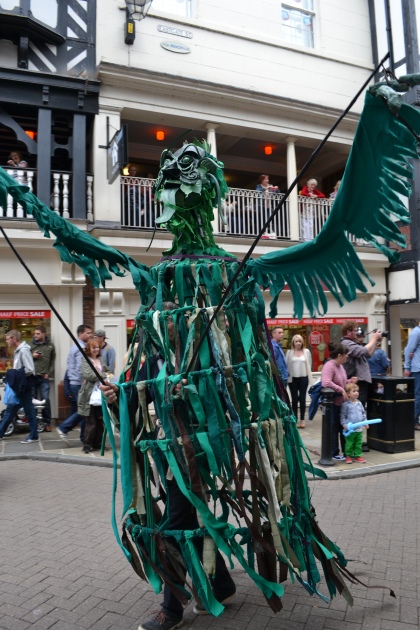Across the country, the period was associated with wells, bonfires, rents and associated charities often being associated with St. John’s Day.
Only one account of a midsummer bonfires exists, that of Wollaton, where there is an account of 8d money being paid by the steward:
‘for bred and ale the benefyre on Mydsomer evyn”
According to an article in the Nottingham Evening Post in 1974 people had recently started ascending Parson’s Hill in Bingham on the night for food and fun, I would be interested if this custom still survives. Festivities were often associated with wells. At Beauvale’s Robin Hood’s Well it was common practice on Midsummer Eve for local people to dance on a lawn space around it in the woods. When the site was turned to a pheasant reserve, the lawn was allowed to grass over and the dancing ceased. A similar tradition is associated with Welham’s St. John’s Well, of which Piercy (1828) in his The History of Retford in the county of Nottingham notes:
“Here was, until lately, a feast, or fair, held annually on St. John’s day, to which the neighbouring villagers resorted to enjoy such rural sports or games as fancy might dictate.”

Being a quarter day, as rents being paid on this date, it is not usual to find that quit rents were paid, in particular the giving of a rose. Newstead Priory have a grant of 8 acres just before the entrance to the priory with right to enclose the same, for which they are to render a rose at the exchequer at Midsummer Patent rolls (1437) and for woods in Carlton Gervase de Clifton gave a rose, which was a common motif and survives in London with the Knolly’s Rose and on and off in Leicester as well. Being a rent day, charities and doles were also established. Epperstone’s Pepper’s Charity took money from rents and gave to poor on this day. Blyth’s Croft Charity gave 40s worth to the poor, Mr Hempstall’s Dole left £100 money for six women and six men in Farndon and Holme Pierpoint Clayton’s dole of £10 and 10s in sixpenny loaves.
A notable survival of this period of rents and sales survives, albeit not always on the 24th is the Laxton Grass sales, the grass of Sykes being used to make hay are sold to ‘anyone who puts smoke up a chimney in Laxton’ therefore all tenants of the Laxton Crown Estate. It is said that it was bought on the longest day but paid for on the shortest day!
The final custom is perhaps the most interesting, of which Deering (1751) in Nottingham via Vetus et Novanotes:
“by an ancient custom, they keep yearly a general watch every Midsummer Eve at night, to which every inhabitant of any ability sets forth a man, as well voluntaries as those who are charged with arms, with such munitions as they have; some pikes, some muskets, calivers, or other guns, some partisans, holberts, and such as have armour send their servants in their armour. The number of these are yearly almost two hundred, who at sun-setting meet on the Row, the most open part of the town, where the Mayor’s Serjeant at Mace gives them an oath, the tenor whereof followeth, in these words: ‘They shall well and truly keep this town till to-morrow at the sun-rising; you shall come into no house without license or cause reasonable. Of all manner of casualties, of fire, of crying of children, you shall due warning make to the parties, as the case shall require. You shall due search make of all manner of affrays, bloudsheds, outcrys, and all other things that be suspected, &c. Which done, they all march in orderly array through the principal parts of the town, and then they are sorted into several companies, and designed to several parts of the town, where they are to keep the watch until the sun dismiss them in the morning. In this business the fashion is for every watchman to wear a garland, made in the fashion of a crown imperial, bedeck’d with flowers of various kinds, some natural, some artificial, bought and kept for that purpose, as also ribbons, jewels, and, for the better garnishing whereof, the townsmen use the day before to ransack the gardens of all the gentlemen within six or seven miles about Nottingham, besides what the town itself affords them, their greatest ambition being to outdo one an- other in the bravery of their garlands. This custom is now quite left off. It used to be kept in this town even so lately as the reign of King Charles I.”
There are a number of references to this practice in Borough records. In 1557-9 12d was given to Damport for going about with his drum on St. John’s Night and St. Peter’s before the watch and 16d for:
“for 2 gallandes wyn that ye wach had on Mydsomer nyght”
Another 8d in 1529-30 for a:
‘pottye of Malse that was dronke at the crosse on Cobcryste Day’
The custom died out by the 1700s it appears, but has been revived at Chester with a midsummer parade on the nearest Saturday which is the closest in spirit to Nottingham’s.
Such are some of the Nottinghamshire customs of midsummer, sadly now largely forgotten so perhaps it’s time to revive them – light a midsummer bonfire, dance around your well and offer sometime for let with a rose payment!
Ross is still researching calendar customs and traditions of the county. Click on the following links if you are interested in such customs.
Traditional Customs and Traditions
re-posted from
http://nottinghamhiddenhistoryteam.wordpress.com/2014/06/17/midsummer-in-nottinghamshire/

